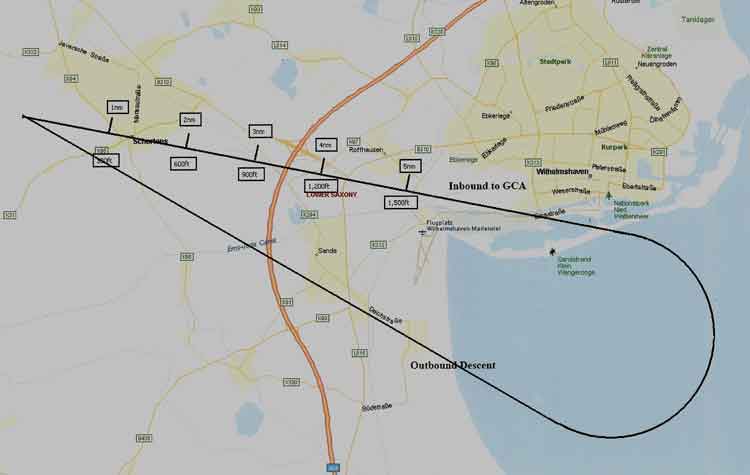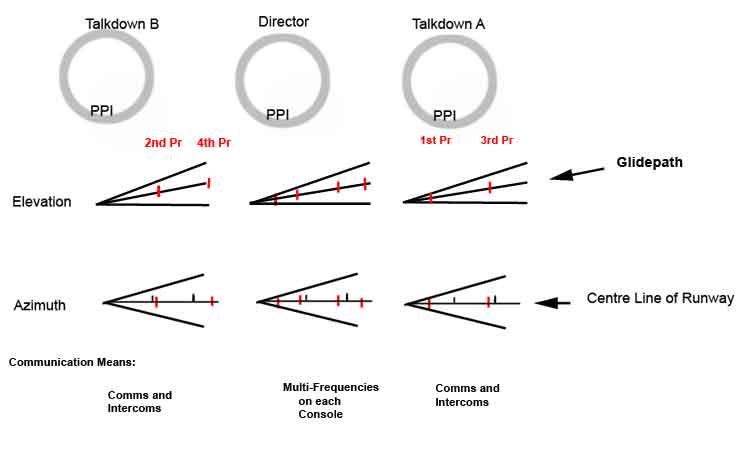

In December 1955 I was moved from Station Flight to become a Flight Commander on
4 Squadron. But I also had responsibilities as Command
IRE and felt there was a need to develop a "Quickie"
GCA procedure for those occasions when pilots overshot and were short of fuel.

There was always an early met briefing for those on the first flight of the day and on this occasion - 7Feb57 - I attended it along with other Wing pilots as I was due to fly on the first wave to try out this new procedure. Each of the four Squadrons
4,
93,
98 and
118 - planned a four ship to practice formation and air combat. There was also another singleton due to fly on that first wave, - a newly arrived pilot on
93 squadron who was completing his familiarisation.

I remember the met briefing well. "No problems today" said the forecaster as he looked out onto a blue cloudless sky. There is a report in the
F540 Squadron Operations Record for
93 squadron which had moved to Jever from Celle. It remarked how pleasant it was to be able to find the airfield easily because of the proximity to the coast line. The downside however was that proximity to the sea also brought dangers of unexpected low cloud or sea fog rolling in which was very difficult to forecast. This proved to be one of those days.

I took off after all the other aircraft, staying below 1,000 feet and trying out the proposed "Quickie"
GCA procedure. I was head down concentrating on blind flying instruments - only looking up as I approached the runway to overshoot and try again. After about 6 circuits I looked up as I overshot and was greatly surprised to find myself in cloud at about 100 feet. The sea fog was rolling in and like me - no one in the Control Tower had noticed it. I alerted them and landed after the next "Quickie" circuit.

Lights - called
bingo lights - came on in the
Hunter when fuel level reduced to 1,300 lbs. That amount was sufficient to divert or to carry out a lengthy bad weather descent and full
GCA radar approach. The normal procedure was to call base as soon as this fuel level was reached and ask for the weather state. If the weather was such that pilots could be sure of a clear weather return to their home airfield they would continue their exercises until the fuel level was down to 800 lbs. That level was sufficient for a quick clear weather approach still having the minimum fuel on landing.

On this occasion sods law operated. Checks on weather at the 1300 lb level confirmed that weather was clear and so exercises were continued until the 800 lb level was reached. But at that time the sea fog rolled in and although it was only a few hundred feet thick it covered the airfield and much of the approaches to it.

The first pair of
aircraft to return thought they could beat the low cloud or fog but it got to the airfield before they did. They overshot, popped out of the low cloud and called for a
GCA - but there were fourteen
others not far behind them and none had the fuel to divert anywhere else.

The Jever Air Traffic -
Jack Payne and others - responded magnificently. There were only two
GCA consoles but by doubling up they were able to control four pairs of
aircraft on
GCA approaches at the same time. That is not to say pilots had normal, calm talkdowns - far from it.
Jeff Jeffrey was hanging on to the wing of
Brian Iles and
Brian had to make such a sharp turn that
Jeff all but lost him in the cloud. In such conditions one should break away but had
Jeff done so a bale out would have been the next inevitable move. So somehow
he found
Brian again and even coped with the unexpected "Cut - full flap go" instruction which enabled the pair to stop on the runway which had suddenly appeared below them.

The new
93 squadron pilot showed some quick thinking too. Having carried out his exercise in manual he climbed up to 10,000 feet to reselect the flying controls back into power as one had to do in those days. Having done so he looked down and was greatly surprised to see that the airfield had disappeared under a sheet of cloud. He descended to where he thought the airfield was and asked for help; but there was no one left to do so. He then saw the two
Hunters who had aborted their first approach pop out of the cloud to go round for a second attempt. In a flash he was in unannounced close formation as No. 3 and he landed with them.

Due to quick thinking and wonderful improvisation by Jever Air Traffic Control everyone got down safely but not everyone had the fuel to make dispersal. It was a very close run thing.
(
Click to see this incident reported in 4 Squadron's F540).
What Air Traffic Control did to save the day!
These memories of that frightening day have been provided by
Peter Drummond-Hay. When he arrived at Jever having been posted from Central Fighter Establishment (
CFE), the Wing Commander Flying,
Wing Commander Geoff Atherton, told him to sort out the
GCA and come up with an efficient recovery system. With a lot of co-operation from Flying Wing and the 4 Squadrons they came up with a modified system developed from the one used at
CFE.
THE JEVER SET-UP: There were 4 squadrons of
Hunter F.4s initially (
4,
93,
98 and
118) and then later 2 squadrons of
Hunter F.6s (
4 and
93) and one squadron of
Swift FR.5s (
2 Sqn). There was a standard
NATO runway,
ATC tower, Approach Control with
CRDF,
GCA (Gilfigen) 3-bay truck on the airfield. Both had multi-frequency
VHF and Intercom.
BASIC RECOVERY: The requirement was that in the event of bad visibility to recover pairs of aircraft for landing at about 2 minute intervals. (It was assumed that there was fuel for a diversion to an alternate airfield available).
24,000 ft. 1. Section of 4 aircraft home to overhead using CR/DF on Approach Control.
22,000 ft. Stack 2,000 ft apart if necessary
20,000 ft. 2. Section separated into two pairs
3. Other sections stacked up as necessary
4. First pair let down by Approach Control
-

QGH Phase - About 20 miles from the airfield
5. Aircraft taken over by GCA Director after
- identification turn (usually on their turn
inbound to the airfield
1,500 ft. - 6. GCA Director controlling aircraft from his PPI display
7. Pairs sent to alternate final talkdown controllers at about 10 miles to go at 1,500ft.

3rd pair of aircraft (on Director's frequency)hopefully will be about 8 or 9 miles behind the 2nd pair
(having been taken over by the Director from the Approach Controller).
The Director can see all the aircraft on PAR and can give initial checks to the 3rd pair such as "Prepare to Descend,
Range & Heading"
The Director will then tell Talkdown A on the Intercom in ATC "Ident 33 at 6½ miles Hdg 285 - over to you".
By this time Talkdown A probably has the 1st pair at about 2 ½ miles.
Talkdown A breaks into his Talkdown for 1st pair and calls 3rd pair: "Ident 33 Prepare to descend" then resumes his
talkdown for the 1st pair. He probably has the 3rd pair on the Glidepath by then.
However, the exact order of events varied because no two approaches and separation distances were ever exactly the same.
The Director would handle the 4th pair in a similar way and hand them over, in due course, to Talkdown B. The Director
would have to be "on the ball" to achieve a smooth flow but the controllers would practice these procedures in the GCA
truck simulating the blips on the PPIs and PAR screens.
Peter thinks that the maximum that they ever recovered using these procedures was about 10 pairs.
The aim was to get 4 pairs of aircraft on GCA final talkdown simultaneously.
Peter's final conclusion was that with a great deal of co-operation - the system worked well and
he does not remember any forced 'overshoots'.
On one occasion, he recalls, when the visibility was less than one mile, and therefore way below
limits, the last pair lead by a certain Squadron Commander, started to look out at about two miles and ceased to obey or
concentrate on Peter's talkdown instructions. It was obvious what he was doing and Peter had a verbal fight
to get him down! His no. 2 meanwhile 'streamed' out his landing on Peter's last heading and was quite calm.
The American GCA was very accurate - right down to the threshold of the runway - we had a great
deal of confidence in it as did most of the squadron pilots.


